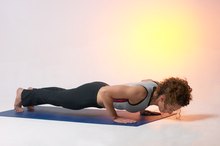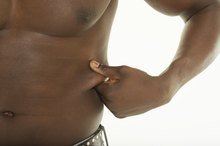What does fact checked mean?
At Healthfully, we strive to deliver objective content that is accurate and up-to-date. Our team periodically reviews articles in order to ensure content quality. The sources cited below consist of evidence from peer-reviewed journals, prominent medical organizations, academic associations, and government data.
- Centers for Disease Control and Prevention: Physical Activity for a Healthy Weight
- Calories Burned in 30 Minutes for People of Three Different Weights
- American Council on Exercise: Butt & Hip Exercises
The information contained on this site is for informational purposes only, and should not be used as a substitute for the advice of a professional health care provider. Please check with the appropriate physician regarding health questions and concerns. Although we strive to deliver accurate and up-to-date information, no guarantee to that effect is made.
How Can I Lose My Hip Bulge?
Many women tend to store excess weight in their lower half, which makes fat deposits on the hips a common "trouble zone." Like any excess body fat, bulges on your hips should respond to lifestyle changes that lower your fat levels, such as cutting your calorie intake and upping your activity levels. However, some hip bulges might actually be a completely normal part of your anatomy, and the excess pounds won't go away as a result of diet and exercise.
Cut Calories to Lower Body Fat
If your hip bulge comes from carrying excess weight, you can reduce its size by lowering your overall body fat levels. Keep in mind that fat loss comes from all over your body -- you can't specifically lose a hip bulge -- and that your "trouble zones," where you tend to store fat, often hold onto stubborn fat the longest. Regardless, lowering your overall body fat levels will slim and smooth any fat bulges on your hips, too.
Most women should aim to cut their calorie intake to 500 calories less than they need to maintain their weight each daily, which allows for 1 pound of fat loss weekly. For example, a 27-year-old woman who is 5 feet, 3 inches tall, weighs 135 pounds, and lives a sedentary lifestyle needs about 1,900 calories to maintain her weight, so she should cut her calorie intake to 1,400 calories daily to lose a pound a week.
If you're very active, and have a higher calorie burn, you may be able to cut 1,000 calories and go for 2 pounds of fat lost per week. For example, that same 27-year-old woman would burn about 2,680 calories if she's active for more than an hour each day. In that case, she could cut her calorie intake to 1,680 calories per day to lose 2 pounds weekly.
Use an online calculator to estimate your calorie needs; then use your calorie burn estimate to decide how many calories to cut daily for weight loss 3. Make sure you eat 1,200 calories daily, no matter what -- or 1,800 calories for men -- to ensure you meet your nutritional needs and keep your metabolism revving.
- If your hip bulge comes from carrying excess weight, you can reduce its size by lowering your overall body fat levels.
- Most women should aim to cut their calorie intake to 500 calories less than they need to maintain their weight each daily, which allows for 1 pound of fat loss weekly.
Increase Your Fat Burn With Cardio
Waist-Slimming Dance Moves
Learn More
Increasing your activity levels helps you burn more calories throughout the day and accelerates fat loss, which can help melt away any excess fat on your hips. The more vigorous your exercise, the more calories and fat you'll burn 3. A 125-pound person will torch 300 calories in a 30-minute high-impact step aerobics class, for example, but just 210 calories in a low-impact step aerobics class. Work out at a rate that feels challenging; you should be able to get out a few words at a time when you're working out, but not carry on a conversation.
Most methods of cardio work the muscles in your lower body, but you should include variety to challenge the muscles in your hips from multiple angles. Try alternating the treadmill, for example, with skiing machines, step mills, and step or boxing classes to work your hips and butt while you burn calories.
- Increasing your activity levels helps you burn more calories throughout the day and accelerates fat loss, which can help melt away any excess fat on your hips.
- Try alternating the treadmill, for example, with skiing machines, step mills, and step or boxing classes to work your hips and butt while you burn calories.
Tone Up Your Hips
Most strength training doesn't burn a ton of calories, so it won't directly burn hip fat, but it can tighten and tone your hips to reduce bulges. Untoned muscle can look flabby, even if it's not actually fat, and strength training maintains some tension in your muscles so you look fitter.
If you're new to strength training, start with body-weight exercises to challenge your lower body, like step-ups, body-weight back and side lunges, squats and body-weight single-leg Romanian deadlifts. Once you've mastered these moves, accelerate your results by adding weights -- such as dumbbells or deadlifts -- to build up your hip muscles. And fine-tune your results with smaller isolated hip exercises; lying side leg lifts, glute kickbacks and Pilates clam exercises all target the muscles around your hips to help you achieve a tighter appearance.
- Most strength training doesn't burn a ton of calories, so it won't directly burn hip fat, but it can tighten and tone your hips to reduce bulges.
Hip Bulges vs. "Hip Dips"
My Thighs Look Terrible With Cellulite & Loose Skin
Learn More
While models in retouched photos often appear to have perfectly smooth hips, it's actually normal to have a slight bump -- sometimes called a "hip dip" -- where your hip bone meets your femur, the large bone in your thigh. Hip bulges caused by your hipbones are more visible in some body types than in others; if you have a more athletic build and a slim figure, your hip dip will be more visible than a woman with a curvier figure who carries excess weight in her hips. If the "bulge" in your hips doesn't look like excess fat tissue, it's likely caused by your bone structure and can't be changed with diet and exercise. In that case, simply strive to live the healthiest lifestyle that makes you happy; you'll look and feel great, which is more important than focusing on a small bump on your hips.
- While models in retouched photos often appear to have perfectly smooth hips, it's actually normal to have a slight bump -- sometimes called a "hip dip" -- where your hip bone meets your femur, the large bone in your thigh.
- If the "bulge" in your hips doesn't look like excess fat tissue, it's likely caused by your bone structure and can't be changed with diet and exercise.
Related Articles
References
- Baylor College of Medicine: Adult Energy Needs Calculator
- Centers for Disease Control and Prevention: Physical Activity for a Healthy Weight
- Calories Burned in 30 Minutes for People of Three Different Weights
- American Council on Exercise: Butt & Hip Exercises
- Hall KD, Sacks G, Chandramohan D, et al. Quantification of the effect of energy imbalance on bodyweight. Lancet. 2011;378(9793):826-37. doi:10.1016/S0140-6736(11)60812-X
- Centers for Disease Control and Prevention. Physical activity for a healthy weight. Updated May 15, 2015.
- Viana RB, Naves JPA, Coswig VS, et al. Is interval training the magic bullet for fat loss? A systematic review and meta-analysis comparing moderate-intensity continuous training with high-intensity interval training (HIIT). Br J Sports Med. 2019;53(10):655-664. doi:10.1136/bjsports-2018-099928
- Ainsworth BE, Haskell WL, Herrmann SD, et al. 2011 Compendium of Physical Activities: A second update of codes and MET values. Med Science Sports Exerc. 2011;43(8):1575-1581. doi:10.1249/mss.0b013e31821ece12
- Donnelly JE, Blair SN, Jakicic JM, Manore MM, Rankin JW, Smith BK. Appropriate physical activity intervention strategies for weight loss and prevention of weight regain for adults. Med Science Sports Exerc. 2009;41(2):459-471. doi:10.1249/mss.0b013e3181949333
- Sanghvi A, Redman LM, Martin CK, Ravussin E, Hall KD. Validation of an inexpensive and accurate mathematical method to measure long-term changes in free-living energy intake. Am J Clin Nutr. 2015;102(2):353-358. doi:10.3945/ajcn.115.111070
Writer Bio
Sylvie Tremblay holds a Master of Science in molecular and cellular biology and has years of experience as a cancer researcher and neuroscientist. Based in Ontario, Canada, Tremblay is an experienced journalist and blogger specializing in nutrition, fitness, lifestyle, health and biotechnology, as well as real estate, agriculture and clean tech.









